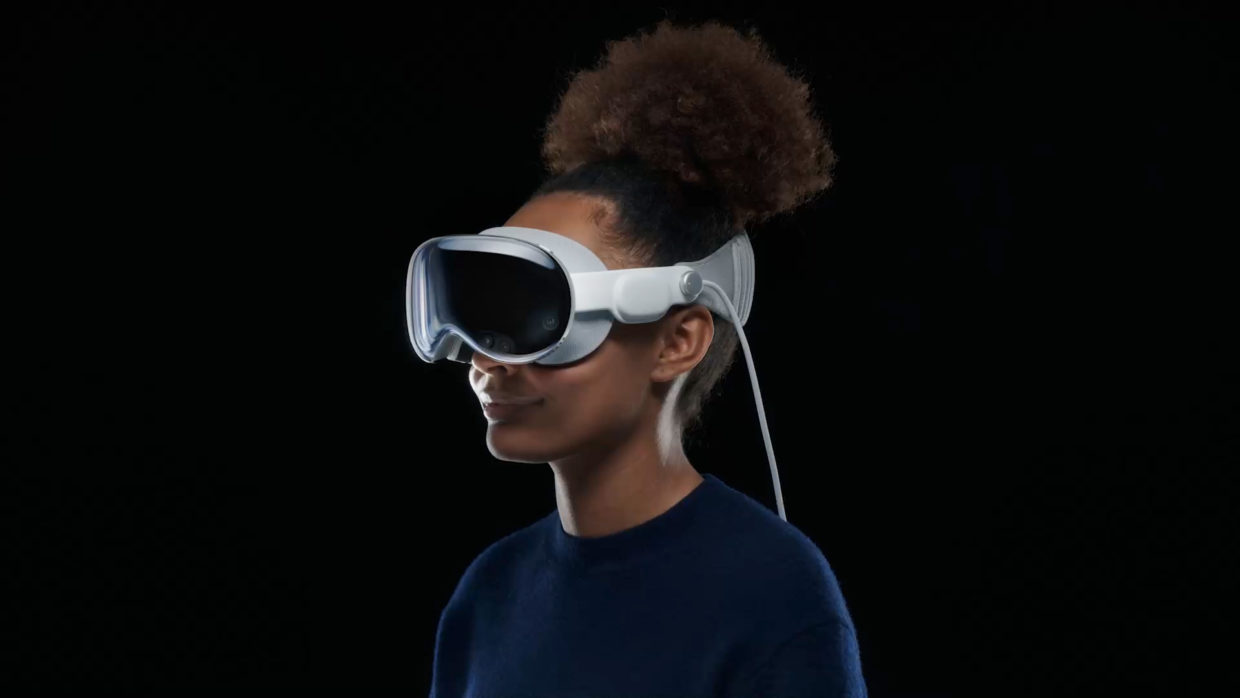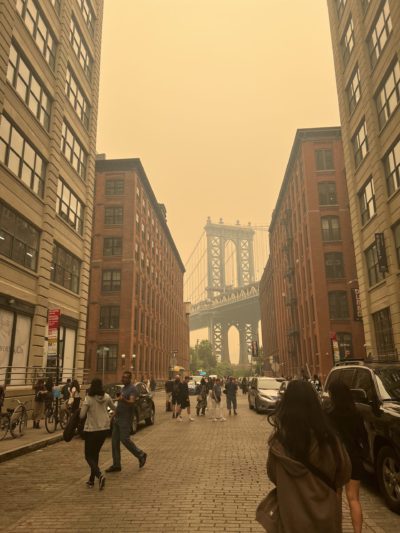 Back to selection
Back to selection
The Editor's Blog
Contemplations and digressions from Filmmaker's Editor-in-Chief by Scott Macaulay
Some Thoughts on the Apple Vision Pro
 Apple Vision Pro
Apple Vision Pro Each Friday I write an original Editors Letter as part of the free Filmmaker newsletter. Always original and not usually archived on the site, the letters consist of essays, thoughts, recommendations and sometimes even early versions of pieces that appear later here. This week I wrote about the Apple Vision Pro and am reposting that piece in updated form here. To subscribe for free to the Filmmaker newsletter, click here.
If you watched any of Apple’s WWDC keynote on Monday, or saw any of its videos, and thought that its new AR headset, the Apple Vision Pro, looked like science fiction, you weren’t wrong. Large scale projections in your living room — that’s from, among other movies, Spike Jonze’s Her. Memories as little dioramas popping up in space: Minority Report. (As is much of the Apple Vision Pro’s use of 3D space as a backdrop for 2D computer screens.) And as for some of the complicated eye scanning the headset is doing, well, that’s the Voight-Kampff test from Blade Runner, the very procedure used to determine whether one is a human or a replicant. (Lest you think I’m being hyperbolic on that one, check out this Twitter thread from artist and developer Sterling Crispin, who worked, he says, for eight years on the device. He describes efforts involving “create[ing] biofeedback with a user’s brain by monitoring their eye behavior, and redesigning the UI in real time to create more of this anticipatory pupil response” and “tricks” used to “infer cognitive state involv[ing] quickly flashing visuals or sounds to a user in ways they may not perceive, and then measuring their reaction to it.”)

But the most obvious reference point that came to mind is Ready Player One, an Ernest Cline novel made into a film by Steven Spielberg. The dystopian story, set 25 or so years in the future, depicts a world made near unlivable due to climate change and where headset-wearing citizens retreat to a virtual reality “OASIS,” where they wallow in the pop culture of the 1980s. It’d be impossible for a new headset like Apple Vision Pro not to seem like it’s referencing Ready Player One, but the association was given an extra oomph when internet commentators like Marques Brownlee pointed out that Apple’s marketing video uses the exact same shot as Ready Player One’s when the headset is donned. Another reason for the comparison: the orange smoky sky greeting me when I left the Filmmaker offices two days after the product launch.
I’ll confess, the part of me that’s interested in new tech and gadgets was excited by the long-rumored Apple headset launch (it was the first WWDC keynote I watched live in years) even as I, like most, didn’t know what various use cases Apple would put forward for the device. So, I was a bit surprised when one of the main target audiences turned out to be “single people living alone in small apartments who would like bigger television screens or desktop monitors.” (Oof!) Other than that, I was surprised by, also like many, the 2D nature of most of the demo’d used cases. When worn, Apple Vision Pro presents your various iOS/iPad OS apps (Notes, Calendar, Safari, etc.) as 2D objects floating in three-dimensional spaces. Using what commenters have said is a remarkably smooth new UI of eye gestures and finger pinches, users can work on spreadsheets, surf the web, watch movies, etc. But why would you want to do these things wearing a headset rather than on your laptop? That obvious question may be a short-term one as various folks, including, for example, the guests on Kent Bye’s Voices of VR podcast, have described the company’s strategy of introducing the project in the most familiar way possible (a new way to interact with your favorite apps!) while developers figure out more compelling use scenarios.
But aside from the IMAX screen in a tiny apartment possibilities, the other thing I took note of was something that’s both semantic and philosophical. Referring to the device’s passthrough capabilities, Apple CEO Tim Cook called the Vision Pro “the first Apple product you look through and not at.” The first thing you see when you put on the headset is indeed your immediate environment, and a small dial increases or decreases the amount of “the real world” that mixes into whatever augmented reality is laid on top. Now, if you haven’t been following AR/VR/XR development closely, you would be excused for thinking that augmented reality is done by projecting new images on top of some sort of glass or lens through which one’s normal vision passes through. (This is actually how the Microsoft HoloLens works.) Apple is doing something different, more like the Magic Leap, which is to create an all digital viewing experience. Wearing the glasses, you are not looking optically at the real world. You’re looking at a screen on which is a video feed from the device’s front-facing cameras, which makes Cook’s “through not at” comment marketing speak rather than fact. According to anonymous Apple employees quoted on this week’s ATP podcast, it’s “a convincing illusion.” I know this is getting a bit Plato’s Cave, but think about this: in both positive and negative ways, more and more of our lives have migrated to the digital sphere since Nicholas Negroponte waxed on about the benefits of this transition in his overly optimistic 1995 book, Being Digital. If a long-term plan is to have us wear devices like the Vision Pro most of the day, our daily reality will simply be a digital — which is to say manipulatable — representation.
In a recommended edition of his Stratechery newsletter, Ben Thompson writes further, discussing the Apple Vision Pro in the context of the move in photography from single lens reflex cameras to mirrorless ones. He also pivots interestingly in the latter part of his newsletter to reservations about the device, which he otherwise finds impressive. He constructs a highly plausible narrative from isolated scenes in the Apple demo. In the first, a children’s birthday party is captured as a 3D video by the Vision Pro. In the second the video is watched by a man sitting alone on a couch. Writes Thompson, “Note the empty house: what happened to the kids? Indeed, Apple actually went back to this clip while summarizing the keynote, and the line ‘for reliving memories’ struck me as incredibly sad. I’ll be honest: what this looked like to me was a divorced dad, alone at home with his Vision Pro, perhaps because his wife was irritated at the extent to which he got lost in his own virtual experience.”
Critics who are deriding the Vision Pro as an unappealing consumer device because of its high price tag — it “starts” at $3,499, but then there are the custom Zeiss lens inserts, (possible) additional memory, the obligatory Apple Care+, etc. — are missing the point. What’s being promulgated here is both a new platform and a new paradigm shift, one that feels possibly momentous to me. I’m no expert in miniaturization, so when and whether the device’s 12 cameras, spatial audio speakers and five sensors can ever be shrunken down to eyeglass size devices (and, remember, there is no Moore’s Law for batteries) I have no idea. Whether a lower-tier, next-gen device with less functionality will be appealing, I don’t know. And I can certainly think of a number of compelling immediate and non-alarming use cases for the Vision Pro — architects, med students, industrial designers will all gain from being able to learn and work in an XR medium, to say nothing of those delighting watching a big-screen movie in a small apartment. I’m also very excited to see what artists in the VR/XR/AR space do, where I’ll choose to enter a constructed environment as opposed to work within a digital environment that’s a simulacrum of a real one just inches from my face. (That’s work we will be covering more at Filmmaker in the coming months, beginning with a new regular XR column next issue by Deniz Tortum.)
So maybe it was just the shock of the smoky skies, but the technodeterminism seeping in from the edges of Apple’s walled garden gave this customarily early adopter a bit of the creeps, something I don’t remember feeling during an Apple event. That said, while I don’t think I’ll be saving up for one of these devices, I can’t swear that I won’t be waiting at an Apple Store when they start doing demos. I’m sure I’ll be seeing some of you there with me.
See you next week.
Best,
Scott Macaulay
Editor-in-Chief
